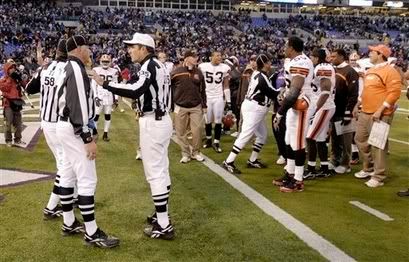 The thought is probably still rattling around in your head somewhere.
The thought is probably still rattling around in your head somewhere."The refs could have gotten in wrong. They could have blown the call. The Browns could have lost Sunday's game, and all we would have been left with is a 10-second video clip showing undeniable evidence that the hand of fate smacked the Browns once again."
Why? That 10-second clip of Phil Dawson's game-tying, double-bounce field goal is irrelevant to the game's outcome in the NFL's eyes.
You probably know by now that the NFL places field goal attempts on a list of plays that can't be reviewed via replay. Their rationale appears to be that if they review one field goal attempt, they'll need to review them all. Coaches and players would come up with all sorts of cockamamie reasons to throw the red challenge flag, thereby disrupting the brisk pace of NFL game action (this brought to you by the league that also brought you the "commercial break-kickoff-commercial break" format.)
There are two basic flaws in the league's rationale, however. One, teams are penalized with spent timeouts for failed challenges in the first 28 minutes of halves, so there is a built-in incentive to not challenge everything under the Sun. Two, field goals are basically cut-and-dried 99.9 percent of the time. If the ball passes between the uprights and over the crossbar, it's good. If it fails to do either or both, it's no good. That's why they make goal posts tall and bright yellow, to contrast the brown football.
For all but a relative sliver of field goal attempts, the naked eye is enough to determine whether or not to stick the three points on the scoreboard.
But for that sliver, the ball that passes over the upright, the ball that knuckles just inside the upright, or the occasional 51-yarder that clangs off the left post, hits the curved extension behind the crossbar and caroms back onto the field of play, a game or a season could be on the line.
The way the NFL currently has it set up, that game or season is riding on the shoulders of two men in striped shirts stationed below the goal post. It's all about what they saw, nothing more. If they huddle up with their crewmates and still can't come to the correct conclusion, then the correct conclusion isn't reached.
Sunday, the two officials who had the closest view of Dawson's field goal couldn't agree on what had happened. When the ball hit the turf and 75,000 held their collective breath, the officials looked at each other. One nodded, the other slowly turned toward the field and made the horizontal "no good" wave.
An NFL executive told ESPN that the game, by all rights, should have ended there. Right or wrong, the call was made and, not being reviewable, should have stood.
It took lobbying from Browns players and the argument of the goal official who had nodded to convince head referee Peter Morelli that the ball did, in fact, pass over the crossbar and hit the extension before falling back onto the field.
The Baltimore faithful, led by Ravens coach Brian Billick, might argue that Morelli received advice from the replay official in the booth, amounting to an illegal review, but the fact remains that Morelli never stepped into the booth and saw the replay with his own eyes. No one on the field did.
Whether the playoff hopes of the Browns and Ravens were inflated or seriously damaged hinged on what amounted to an impromptu trial without evidence; a "he-said, he-said" in which the person who made the more convincing argument won -- not necessarily the person who was right.
In this case, the correct person made the more convincing argument and the Browns didn't get shortchanged out of the chance to win that they rightfully deserved. But it could have easily gone the other way.
Instant replay is geared toward helping to eliminate human error from the process of officiating games, particularly key plays. NFL officials should be able to differentiate between using it and abusing it and make judgments on reviewable plays accordingly. But the NFL is so hung up on making sure instant replay isn't abused by teams and officials, they've taken away a legitimate use -- perhaps its essential use: making sure games that are decided on last-second field goals are decided correctly.
What does it say about the league that a pass play that leads to a game-deciding field goal can be reviewed, but the field goal itself can't? When the league's big thinkers sit down together after the season, they might want to meditate on that a bit.
Luckily for those of us in Cleveland, replay wasn't necessary to come to the right conclusion. But at some point -- maybe in a playoff game -- it might.
A 51-yarder off the foot of Phil Dawson to decide a regular season game might not be so big in the grand scheme of things. But if that ball is coming off the foot of Adam Vinatieri to decide the AFC Championship, with camera angles galore, the officials might want to have the option of going to the replay. The league's front office should oblige, for everyone's sake.
Nov 22, 2007 7:00 PM